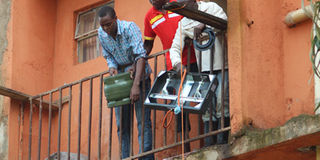Poor cement blamed for collapsed buildings

Good Samaritans help tenants vacate Storm apartments, in Jogoo area within Kisii town that was sinking on April 15, 2015. PHOTO | BENSON MOMANYI | NATION MEDIA GROUP
What you need to know:
- The five-storey residential building was left leaning dangerously, to the shock of the nearly 100 tenants who were preparing to go to work.
- County Executive in charge of Administration Peris Onsarigo said tenants and residents living within a 30-metre radius of the building have been ordered out.
- While grade 42.5 cement was designed specifically for multi-storey buildings in developed countries, grade 32.5 grade cement is frequently used in East Africa as it more readily available.
Experts have singled out the use of low grade cement in construction of house columns for the collapse of buildings across the country.
This was claimed even as panicky tenants fled a residential flat in Kisii on Wednesday morning when it started sinking.
The five-storey residential building was left leaning dangerously, to the shock of the nearly 100 tenants who were preparing to go to work.
Ms Fridah Kwamboka, a tenant, said she was fast asleep when she received a mobile phone call from a friend who wanted to know why people were fleeing the building in which she lived.
Another tenant, Mr Erick Kombo, said a slight tremor on Tuesday evening left big cracks on the walls of the building.
County Executive in charge of Administration Peris Onsarigo said tenants and residents living within a 30-metre radius of the building have been ordered out. In Nairobi, a panel of experts in architecture, engineering, construction and technology said there was need to adopt the use of high strength concrete for building.
Experts noted that cement grades 32.5, 42.5 and 52.5 were designed for different applications such as plastering or structural work like beams and columns.
While grade 42.5 cement was designed specifically for multi-storey buildings in developed countries, grade 32.5 grade cement is frequently used in East Africa as it more readily available.
“It becomes a problem when you substitute one grade with the other; no wonder the frequent collapsing of buildings,” said Mr Pradeep Paunrana, ARM Cement managing director.
Mr Steve Oundo, Housing Principal Secretary asked the industry to educate users so that they can buy the correct cement.
“When contractors use grade 32.5 to cast columns, they end up spending larger quantities of cement in the process, which is very expensive,” he said.





